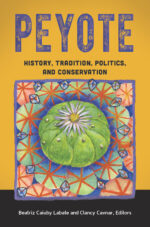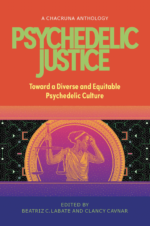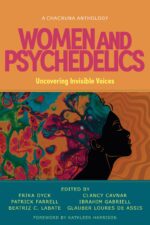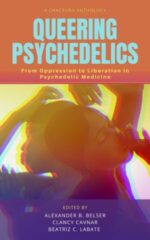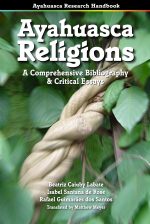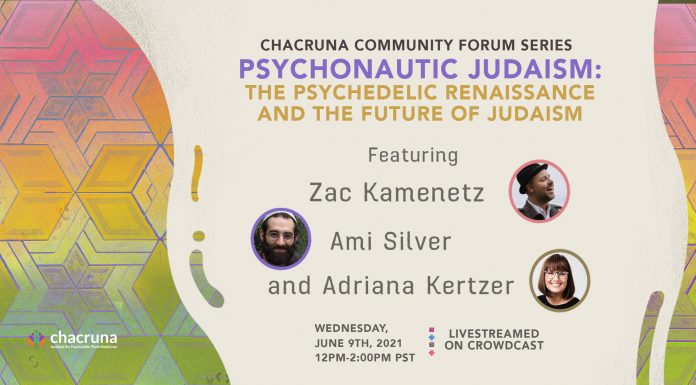- After 2024, the Scenario for Psychedelic Therapies Can Only Improve - January 16, 2025
- Symposium in Brazil Debates Psychedelics at a Political Crossroads - December 13, 2024
- Conference in Rio Defends Psychedelics in Public Health - December 11, 2024
Part 3 – The almost invisible religion in Brazil’s Northeast
Master Ritinha, a spirit just incorporated into the owner of the house, André Luiz do Nascimento, 50 years old, approaches the journalist, who is lying on the green yoga mat. Standing, she spreads her hands over his stretched-out body as if groping an invisible wall. After a few minutes she kneels down and asks permission to “make a cure.” With judgment and skepticism disconnected after the second dose of jurema-preta [black jurema] (Mimosa tenuiflora) and Syrian rue (Peganum harmala) teas, the reporter agrees.
Master Ritinha runs her hands over his chest, stops on his right lung, and they begin to tremble. In a trance, she bends down and presses her mouth to his t-shirt, blowing or sucking in air—it’s hard to tell. Her hands wander again, then stop over his lower abdomen. She gives a new tremor, this time more intense. The sensation, between intriguing and fun, is one of comfort and care; almost a caress.
Ritinha stiffens and asks, at the top of her voice, for a white candle to be handed to her. She rubs the paraffin vigorously into the journalist’s belly, then breaks the candle into maybe four pieces, which remain joined by the wick, and throws it away. She gets up, without saying a word, and resumes her walk across the room with her wide-brimmed white hat trimmed with a colorful scarf. From time to time, she laughs.
At least three other people enter a mediumistic state during the Catimbó ceremony, where Jurema Sagrada masters and Caboclos—African and Indigenous spirits and deities—are incorporated. André Luiz’s one-story house is located in Redinha, a neighborhood on the outskirts of Natal, the capital of the Northeastern state of Rio Grande do Norte.
The most lasting trance is that of the officiant, Rômulo Henrique Pereira Angélico, 41 years old. He receives his master-guide, Manoel Germano, who performs his teachings between the chanted of songs intoned in a powerful bass voice. One of the songs invokes Exu, an Umbanda entity with which a Jurema Sagrada table is usually opened. From 10 pm to 5 am, the songs cover a wide syncretic spectrum, from Caboclo beings, like the master Pena Branca and the jurema tree, to Catholic figures like Our Lady and Saint Francis. Germano, incorporated, makes Rômulo’s body limp around the room. Sometimes with a black hat on his head and a pipe in his mouth, speaking with a rustic accent.
There are a dozen people in the house, in addition to masters Rômulo and Breno Gabriel, who are in charge of the ceremony. The only beginners in the Catimbó and Jurema Sagrada rituals are the journalist and two Argentine girls. While waiting for Sydma, Rômulo’s wife, to arrive, they both enlighten newcomers about the combined effect of the two drinks. The consecrations would be offered three times during the night, and each person would only take the drink if and when they wanted it.
They were told that they might have visions, vomit, and even experience the sensation of dying. But everything would pass in its own time, and the cleansing would be beneficial for everyone. A round of “anamnesis” follows, in which each person can say what ails them, or what their purpose of being there is.
Mestre Breno sounds more reassuring, and this is the role he plays during the seven-hour session. He is delighted with the title of the journalist’s book, Psiconautas (Psychonauts) (Fósforo Publishing House, 2021) and says that the ship would reach a safe haven that day. “The boat has an owner, André Luiz, captain, Rômulo, and boatswain” —Breno himself.

He wears a cap of blue feathers with a larger yellow feather projecting out at the top, and a canga (a light piece of cloth popular on Brazilian beaches) on his shoulders with a pattern of peacock feathers, symbolizing for him a sacred Tupinambá Indigenous mantle. He blows jurema in a vaporizer, spreading sweet-smelling smoke, and in his hand, he carries a kind of Indigenous club.
They would travel across a sea of ideas and they would fish, says the master, with everyone safely returning to dry land. Then he sings the song “Fisherman’s Suite” (Suíte do Pescador) by Dorival Caymmi: “My raft is going to go out to sea / I’m going to work, my dear / God willing that when I come back from the sea / I’ll bring a good fish / My companions will also return / And we’ll thank God in heaven.”
The only beginners in the Catimbó and Jurema Sagrada rituals are the journalist and two Argentine girls.
The consecration of two teas is a neoshamanic innovation in urban ceremonies that claim their roots in Catimbó. Indigenous rituals employ the so-called wine, based on jurema-preta, some type of alcohol, and honey, in addition to other ingredients and herbs kept secret, but which do not necessarily have a psychedelic impact.
In the case of the night ceremony held in Redinha, the teas served fit the concept of “juremahuasca.” This is the nickname for the mixture of jurema and Syrian rue that reproduces the magic of ayahuasca, the tea used in religions such as Santo Daime, Barquinha, and União do Vegetal (UDV).
Ayahuasca results from the long boiling of two plants, the chacruna bush (Psychotria viridis) and the mariri, or jagube, vine (Banisteriopsis caapi). In juremahuasca, jurema is used instead of chacruna as a source of dimethyltryptamine (DMT), a substance that alters consciousness. Syrian rue also acts as mariri does: providing beta-carbolines, compounds capable of inhibiting an enzyme (monoamine oxidase, MAO) that would otherwise degrade DMT in the digestive tract, preventing its arrival in the bloodstream and brain. Syrian rue, as the name implies, is not even native to Brazil. It grows in the arid regions around the Mediterranean and can be purchased over the internet as Jurema neoshamans do.
The brown tea made by Master Breno, with a peculiar vegetable flavor, is drunk around half an hour before the jurema. The second drink is black and very bitter and was made by Master Rômulo. The combined effect can be described as very similar to that of ayahuasca, where DMT is already mixed with MAO inhibitors, and at the same time, very different. Even with just the drink with Syrian rue, you can already feel an internal tremor.
The Mediterranean plant contains the harmine and harmaline alkaloids, apparent from the scientific name Peganum harmala. They also act as anxiolytics, to lower blood pressure and increase heart rate.
The first manifestations after drinking the jurema are visual and more luminous than those of ayahuasca, in the journalist’s experience: with eyes closed, sparkling dots and colored spots appear, but they do not fill the entire visual space, as they would if they appeared in a kaleidoscope. Soon, they evolve into more three-dimensional, “architectural” images, such as “palaces of black glass and points of light,” as the reporter writes down in his notebook. This intensely visual part doesn’t last long.
To encourage introspection, Rômulo plays esoteric Andean, Indian, Amerindian, and Christian electronic music on a loudspeaker connected to his laptop. Even trying to direct attention to male figures, such as a brother or a father, only women appear on the screen of the journalist’s mind.
Rômulo had played the song “Prayer of Saint Francis,” and perhaps this is why the predominant theme becomes forgiveness. There is a silent apology to an ex-girlfriend for lack of effort to publish a story that might have helped her to be included in an experimental cancer treatment group. This is the moment of greatest emotion, although it is not full of guilt. Another painful and serene lament for not giving her the support that would have in no way altered the course of her illness, but which she would certainly have appreciated.
The first manifestations after drinking the jurema are visual and more luminous than those of ayahuasca, in the journalist’s experience: with eyes closed, sparkling dots and colored spots appear
In 2005, teaching at a public school on the south coast of Rio Grande do Norte, history teacher Rômulo knew little about Catimbó or Jurema Sagrada. He could barely distinguish them from Candomblé or Umbanda. The local school network organized a science fair with the theme of “religion” in the town of Canguaretama, and only Christian themes appeared. The future master proposed a study of cults with African roots, but a mere 14 out of 2,600 students were interested.
From there, he delved into the study of the religiosity of the Northeast of Brazil, which led him to read the works on Catimbó by Câmara Cascudo and Mario de Andrade, important twentieth century ethnologists. He also started visiting Indigenous communities and terreiros, locations of such ceremonies. He interviewed catimbozeiros, leaders of Catimbó ceremonies, and took notes. In one of these conversations, he felt what he calls “pre-mediumization,” understanding it as a call to initiation.
From 2009 onwards, he learned from shamans, masters of the Jurema Sagrada (among them Breno and Maria Fernandes) and of Umbanda (Francisca Bezerra Honorato, Neta of the Umbanda terreiro Ogum-Odé) to prepare the jurema with water, honey, varieties of wild cashew and passion fruits.
In 2013, he opened his own terreiro, the Centro Espiritualista Casa do Sol Nascente do Rei Malunguinho (King Malunguinho House of the Sunrise Spiritualist Center). The terreiro ended up closing after an episode of vandalism, in which objects of worship were broken and pets were killed. “I don’t make sacrifices,” explains Rômulo, referring to the widespread suspicion of witchcraft levelled by Christians against African-Brazilian religions.
He is currently attempting to open a new space for Catimbó, the Centro Espiritualista e Beneficente Mestre Manoel Germano (Manoel Germano Spiritualist and Beneficent Center). The ceremony at Redinha was part of the fundraising effort. “Jurema is many things: various kingdoms, the drink, the plant, the Cabocla spirit—a world,” explains the master. Each enchanted kingdom is ruled by a king, and in its cities reside masters received in the rituals, such as Manoel Germano, incorporated by Rômulo. “The tea helps to communicate with these enchanted beings.”
Both the living and the dead are called “masters.” After death in this world, they continue to live enchanted in specific cities and kingdoms, from where they are invoked in the chants to come and help in the works. They have their own personalities, they are “ancestors, men and women who walked here on Earth made divine,” according to Rômulo: for example, Maria do Acais, Zé Pilintra, Caboclo Pena Branca, and so on. “Others are animals, or plant spirits,” explains the catimbozeiro. “It cannot be something imaginary, since it manifests itself in real cures, in messages [pieces of advice] that are carried out.”
Jurema is many things: various kingdoms, the drink, the plant, the Cabocla spirit—a world,” explains the master. Each enchanted kingdom is ruled by a king, and in its cities reside masters received in the rituals
“Who am I to say mermaids don’t exist?” The rhetorical question emerged in an interview in Rio de Janeiro with anthropologist Rodrigo de Azeredo Grünewald, professor at the Federal University of Campina Grande in the northeastern state of Paraíba, and author of the book Jurema (Mercado de Letras, 2020). “Anyone who only thinks about molecules thinks they [practitioners of Jurema] are making up fairy tales.”
Jurema entered Grünewald’s life in January 1990, when he began his ethnographic work with the Atikum people, one of several who use the drink in the northeastern backlands known as sertão, an area of the semi-arid biome caatinga where the pioneer tree, Mimosa tenuiflora, thrives. Having spent time in the Barquinha ayahuasca religion, the native of Rio de Janeiro was no stranger to psychedelics when he surrendered to the charms of Jurema. From January 1997, he began performing juremahuasca rituals for friends at his weekend retreat in Jacarepaguá in the outskirts of Rio de Janeiro. “Jurema is the cosmos in a little cup.”
Today, Grünewald hardly ever takes the drink, from which he distanced himself from 2005 onwards. He has become more interested in the rituals he has observed and in which he has participated with the Indigenous people of the Northeast, than in the psychedelic effect of the plant itself, as his experiences in these rituals became more fulfilling than the trips. Furthermore, the use of jurema forms the basis of the traditions that he studies and that the dominant culture has repressed since the times of the Inquisition. But this repression has been in vain, as Jurema has persisted in the Brazilian culture and imaginary, albeit underground.
In the classic work of Brazilian literature, Iracema (1865), by José de Alencar, which generations of Brazilian students have read for university entrance exams, the root wine is mentioned:
When they were all seated around the great fire, the minister of Tupã orders silence with a gesture, and, three times calling the terrible name, he is filled with the god who inhabits him:
— Tupã!… Tupã!… Tupã!…
From grotto to grotto the echo in the distance reverberated.
Iracema comes with the iaçaba [clay pot] full of the green liqueur.
Araquém decrees dreams for each warrior and distributes the jurema wine, which transports the brave Tabajara warrior to heaven….
Everyone feels happiness so vivid and continuous that in the space of the night they think they live many moons. Mouths murmur; the gesture speaks; and the Pajé shaman, who hears and sees everything, gathers the secret in the depths of his soul.
Who, however, remembers Alencar? Or do you stop and think of verses like “The emu grunted / In the trunk of the jurema,” popularized in the voice of singers Jackson do Pandeiro and Gilberto Gil? Or, even when Chico Buarque sings in “A Violeira” (The Guitar Player) that “Seeing Ipanema / Was like taking jurema / What a scene in the cinema”?
In the Northeast, according to Grünewald, the jurema traditions have survived the dominant culture, internal colonialism, and cultural and religious imperialism. They planted roots deep enough to take the sap to neoshamans who, like Rômulo, embrace the trunk of the jurema.
Grünewald wrote in his book: “In postmodernity, some new subjects promote, with their mystical experimentalism with jurema, a critique of this asymmetry, trying to a certain extent to stop the arrogance of medical science and modernity as a whole, whose concepts do not allow the individual to listen to the wider world (cosmos).”
With the multiple manifestations, figures and forms of this religiosity centered on the caatinga tree, Grünewald prefers to speak of a “Jurema complex.” Originating among Indians from the sertão backlands, it has undergone a process of de-ethnization. Indigenous and black people from the humid coast entered the semi-arid caatinga, fleeing enslavement. Afterwards, they returned to the coast with more mixed-race features and the Catimbó ritual. Repression and stigmatization of the cults, however, continued.
“Jurema is mestizo,” summarizes the anthropologist. In his view, this is the reason why Jurema has only recently interested urban mystics in Brazil, although it has always been present, symbolically or physically, in the terreiros and rooms in the Northeast of Brazil, where it was practiced in secret but in a local way, and did not expand to the Southeast of Brazil, for example. Nevertheless, the ayahuasca religions have spread through the big cities of Brazil, which were lulled by visions of lush virgin forests and archetypal and pure Indians who walked naked through the jungle. This took place even though the ayahuasca religions are syncretic manifestations themselves, in which Indigenous myths are mixed with the Catholicism of riverside caboclos of mixed race and rubber tappers, many of them, by the way, migrants from the Northeast.
Anthropologist Luiz Assunção, a professor at the Federal University of Rio Grande do Norte (UFRN), also notes the plurality of Jurema Sagrada: it is an Indigenous heritage that has mixed with African influences and popular Catholicism. Official Catholicism, however, has always condemned Catimbó as witchcraft and a demonic cult. This has planted the seed of the police persecution against its practitioners and those of Umbanda.
“Jurema has always existed as a ritualistic practice, it has been spreading, spreading out, and reaching urban populations, but intolerance has made it close up into a practice of small groups around a living master, in individual consultations,” says Assunção, author of O Reino dos Mestres – A Tradição da Jurema na Umbanda Nordestina (The Kingdom of Masters – The Jurema Tradition in Northeastern Umbanda) (Pallas, 2010).
For Assunção, the survival of Jurema is connected to the Brazilian state’s disregard for the poor in Northeastern towns and cities. Without adequate access to health services, poor people have resorted to consultations with the masters, great connoisseurs of medicinal plants, and to their mediumistic “messages” and healing plants. “There is a political process around religious leaders, which takes shape in the meetings of juremeiros held in some northeastern states, linked to the construction of a belonging based on the appreciation of signs of Indigenous tradition.”
The association with Umbanda gained institutional strength in the 1960s, when the northeastern federations of this other syncretic religion originating in Rio de Janeiro began to emerge, including African orixá deities, Catholicism, and Kardecism.
Catimbozeiros and juremeiros took shelter in the federations in which they saw a possibility of protection from repression. But this protection did not materialize, and until today, the terreiros have suffered attacks, as happened with Mestre Rômulo’s terreiro.
In this process, Jurema was in a subordinate position, as an appendix of Umbanda houses. Social prejudice remained strong. “Even today, the middle class does not go to Jurema ceremonies,” says Assunção; intellectuals are instead attracted to Candomblé and its image of greater African purity.
However, there is a movement of revaluation of Catimbó in the urban environment, in initiatives such as that of Rômulo Angélico, and even a recent flow of catimbozeiros from Natal to São Paulo. But it’s not just in the northeastern capitals that their practices are reappearing.
“There is a political process around religious leaders, which takes shape in the meetings of juremeiros held in some northeastern states, linked to the construction of a belonging based on the appreciation of signs of Indigenous tradition.”
The pajé (shaman) Isaias Marculino da Silva, 34, also known as Guarapirá, arrives already painted at Matinha do Pau-Ferro, an island of trees in the sea of sugar cane around the Potiguara Indigenous Lands in Baía da Traição (state of Paraíba). In the trunk of the car are bombos (drums), pipes, a jug of jurema, a feather headdress, and a skirt made of embira fibers.
On that May 16, another full moon ritual took place, and these ceremonies have been repeated every month since 2013. Isaias speaks to about 30 participants and explains that the honoree of the night is the shaman Chico, the oldest shaman in the region, who had died some days before at the age of 76.
The Jurema table is placed on the floor, with lit candles, the ceremonial drink, pipes (one of them with several stems), a ceramic plate with tobacco, and maracas. To the right, a group of women dressed in embira skirts settle into plastic chairs. One of Isaias’ sons, Iakarynauê, 10, also wears an embira skirt.
The minibus from the Federal University of Paraíba (UFPB) arrives with students brought by Lusival Antonio Barcellos, professor of religious sciences. In the group is Surama Santos Ismael da Costa, a mathematician who, three weeks later, would defend a doctoral thesis on this same ritual, at UFPB, supervised by Barcellos (who is also tutoring Isaias with his MA dissertation).
Surama explains that the incomprehensible speech for the journalist is a Lord’s Prayer in the Tupi language:
Oré rub, ybákype tekoar
I moetepýramo nde rera t’oîkó
T’our nde King!
T’onhemonhang nde remimotara ybype
Ybákype i nhemonhanga îabé!
Oré remi’u, ‘ara îabi’ondûara, eîme’eng kori orébe.
Nde nhyró oré angaîpaba resé orébe, oré rerekomemûãsara supé oré nhyrõ iabé.
Oré mo’arukar ume îepé temptation pupé, oré pysyrõte îepé mba’ea’iba suí.
When the fire is lit, the ritual opens with the gaita, a kind of flute with a gourd. The opening song is started by the shaman, and the stanzas are then repeated by the others. “Who painted the fine porcelain / It was the Flower of Wonder / Father and Son and Holy Spirit / Son of the Virgin Mary,” says one of them.
The drink served was made by Isaias with jurema-branca (white jurema, perhaps Mimosa verrucosa), cold water, wine, honey and leaves, bark, and roots or seeds of plants that he does not reveal. Each visitor receives half a 200 ml disposable plastic cup, the use of which are imposed by the pandemic (before, everyone used the same bowl). Only the shaman, the elders, and the initiates take the drink several times throughout the ceremony.
The flavor is vegetable, sweet and alcoholic, reminiscent of genipapo liqueur. It has zero psychedelic effect, as the shaman had said. “It has no hallucinogens, but it does contain energy,” assures Isaias. “It is a permission portal for spirituality. It depends on you.”
In her PhD thesis on the ritual, which took four years to complete, Surama describes the drink’s effect on her:
After the third bowl of Jurema, peace reigned within me. He [Isaias] bowed at my feet and began the smoking ritual. I was afraid of feeling bad about the smoke, but, to my surprise, as the Caboclo blew his pipe, putting his mouth to the opening of the furnace, the opposite end to where people usually inhale, its smoke sharpened my senses as it covered my body.
I perceived a wonderful smell of the herbs being burned, I heard the sound of the maraca more intense and clean, and I felt, even more, the sweet taste of Jurema in my mouth. My body was shaking. With no strength in my legs, I fell to my knees on the floor. At that moment, I had an explosion in my heart, which made it beat at an accelerated rhythm, incompatible with the calm that inhabited me.
The ceremony continues with a number of lines chanted until 10 pm, invoking Jurema, several other Caboclos, and Oxóssi. “I call the cabocla native women of pity, I called them to come help us / Where is Jurema’s strength, where is the strength Jurema gives / Oh women of pity, oh women of pity, pity me, pity me.”
Some participants dance in a circle around the table, counterclockwise, stomping their bare feet on the floor, some marking the rhythm with maracas. In addition to Isaias and one of the elders, three Black women go into a trance and receive entities. Bent over, one hand on their forehead and the other on the back, they make grunts and sounds that resemble animal noises. The moon shines between the ironwood leaves.
Towards the end, one of the seated ladies invites anyone who wishes to consult with the Caboclo das Matas Sagradas (Caboclo of the Sacred Forests) incorporated by Guarapirá. A long queue forms.
One by one, people kneel before the entranced pajé. The Caboclo transmits messages to them in an inaudible voice, touches their shoulders, head or chest, enveloping them in copious smoke coming out of the pipe blown out of the mouthpiece of the pipe.
When the Jurema table is closed, again after the gaita is played, everyone sings: “The village caboclo when he goes to the sea to fish / From his hair he makes the yarn, from the yarn he makes landuá / The caboclos in the village sessando the sand” (the landuá is a funnel-shaped hand net to catch small fish, and the verb sessar means to sift).
The entourage then goes to the shaman’s house in the village of Lagoa do Mato. A supper of tapioca, rice, and fish is served in plastic bowls, in an atmosphere of joy and communion. Two military police officers from the Indigenous Patrol of Paraíba share the meal. The detachment was created, it is claimed, to provide security to 32 villages of the Potiguara people in the municipalities of Baía da Traição, Rio Tinto, and Marcação.
It wasn’t always that peaceful. The white police, before and after the recognition of the ethnic group from 1930 onwards, were always more on the side of the sugar cane mill owners who had invaded the Potiguara lands. Rituals were repressed or prohibited by Portuguese catechizers and administrators in the colonial period, their language was eradicated, and shamans were condemned by the Inquisition as sorcerers; this prejudice is still widespread today.
In the twentieth century, the Indigenist bureaucracy (the SPI, Marshal Cândido Rondon’s Indian Protection Service, and Funai from 1967 onwards) began to consider rituals such as toré, with or without the use of jurema, as a clear sign of “Indianness.” This was one of the prerequisites for formalizing Indigenous territories. The resurrection of ceremonies occupied the epicenter of the ethnogenesis movement in the Northeast, a resurgence of Indigenous peoples who had lost their traditions.
Isaiah heard this call in a dream. He was under a tree that looked to him like a cave. He saw chiefs of the past and present, saddened by the weak spirituality of the Potiguara. Caboclo da Mata Virgem and Cabocla de Oxóssi da Jurema called him to “seek the strength of the enchanted ones to raise their strength.” The future pajé Guarapirá then dedicated himself to studying, on two fronts. From older shamans, like the late Chico, he learned the science of Jurema—how to prepare the wine, where to find it, and how to use power plants, the strength of pipes, drums, and maracas.
At university, he majored in Education. He studied ancient Tupi to teach the language and is now taking an MA in Religious Sciences at UFPB. Isaias is director of the Celina Freire Rodrigues municipal school, in the neighboring village of Cumaru, which has about 80 elementary school students. He teaches Tupi there and at the Angelita Bezerra high school, in the village of Silva de Belém, in the municipality of Rio Tinto, which has two hundred students.
“The spiritual ritual must continue,” he says; refusing, however, to give it the name of Catimbó or Jurema. “It’s a Potiguara ritual, the result of this miscegenation. We revere some entities, there are chants with the names of saints, but it is our ritual, of gaining more strength.”
Rituals were repressed or prohibited by Portuguese catechizers and administrators in the colonial period, their language was eradicated, and shamans were condemned by the Inquisition as sorcerers; this prejudice is still widespread today.
The Catimbó Jurema session in Natal, in the neighborhood of Redinha, ends at around 5 am, with reports on the experiences participants had, each one, in turn, holding the club brought by Master Breno. Some get emotional when talking about sadness and trauma.
It’s time to eat, after a long fast, with a mixture of snacks: cashew nuts, potato chips, mini drumsticks, bread, and cake, brought by visitors. Disembodied from Master Ritinha, André Luiz, a nurse and integrative therapist, speaks to the journalist. He says he felt a strong field around the visitor, like a defensive barrier. When he managed to get past it, he first noticed a focus on the lungs, “which, in Chinese medicine, is the site of sadness.”
He adds, however, that the biggest problem was in the stomach: “Something very dark, a knot of dirt.” He asks if the journalist relates this to a health issue. A prostate surgery is mentioned, to which the medium reacts with: “Oh, that’s it then!”
The operation, however, had taken place nearly three years earlier, and tests since then indicate complete recovery. The reporter wants to say that everyone has some problem with the abdomen (diarrhea, colic, nausea, heartburn, gas, liver problems, gallbladder, stomach aches…), but he holds the thought to himself. “Your healing wasn’t three years ago. It was today,” counters the owner of the house. “From here, things will happen in your life.”
Three weeks later, back in São Paulo, the skeptic wakes up at 4:23 am with pains in his stomach, which grow to the point of taking him to the hospital: stones finding their way out of his left kidney. Not even under the influence of morphine is he convinced of Master Ritinha’s powers, but he thanks her, and Jurema, for the gesture of care.
This is the third part in a series originally published in Portuguese by the Brazilian daily newspaper Folha de S.Paulo https://www1.folha.uol.com.br/ilustrissima/2022/07/cultos-com-alucinogeno-da-jurema-florescem-no-nordeste.shtml
Take a minute to browse our stock:
Did you enjoy reading this article?
Please support Chacruna's work by donating to us. We are an independent organization and we offer free education and advocacy for psychedelic plant medicines. We are a team of dedicated volunteers!
Can you help Chacruna advance cultural understanding around these substances?



